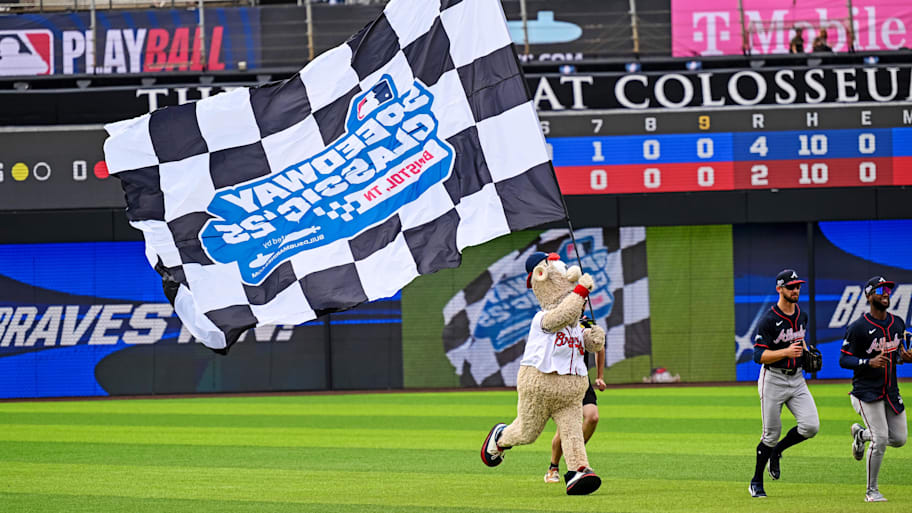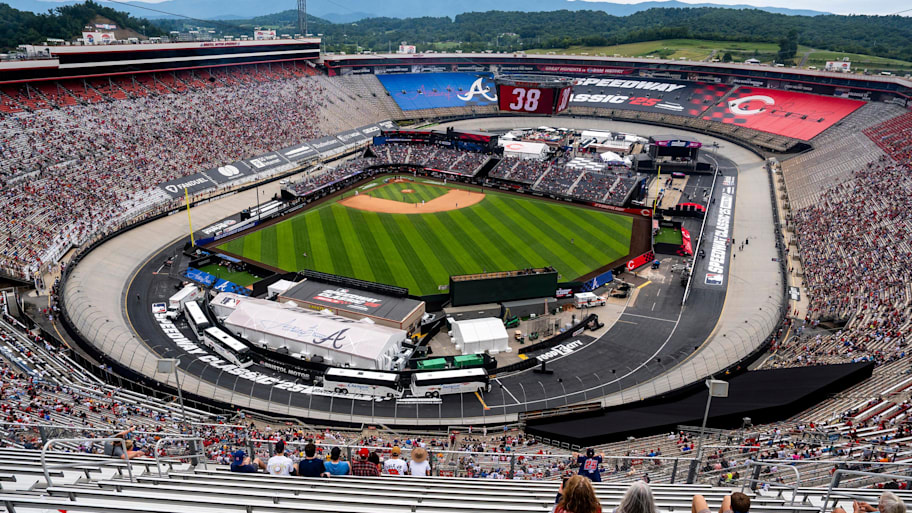BRISTOL, TENN. — On Sept. 2, 1961, just 41 days after the Bristol Motor Speedway opened in the foothills of the Blue Ridge Mountains, the race track hosted an exhibition NFL game on land that had previously been a dairy farm. Billed as the “First Annual Pro-Bowl Football Game,” the clash between Philadelphia and Washington attracted just 8,500 fans and failed to generate a profit. One of the players would later call it “the worst field I had ever seen.” There was no second iteration.
R.G. Pope, one of the three original co-owners of the track—and my great, great uncle—sold his stake in BMS due to his disappointment not long after. It’s safe to say he should've been more patient with his investment.
Bristol Motor Speedway has become known as The Last Great Colosseum, one of the country’s crown jewel stadiums. It hosts two NASCAR Cup Series events per year and is renowned in racing for its speed and high, 30-degree banks on the curves that allow it to lay claim to being the “world’s fastest half-mile.” Its capacity ballooned to over eight times its original figure over the course of several expansion projects, making it second to only the Indianapolis Motor Speedway among U.S. racing venues in terms of capacity. And in a reversal of fortune on the gridiron, BMS hosted a 2016 clash between the Tennessee Volunteers and Virginia Tech Hokies that drew 156,990 fans, a college football record.
This weekend, the track helped MLB set a regular season attendance record, as the Speedway Classic between the Braves and Reds sold 91,032 tickets, topping the 84,587 fans who watched Cleveland host the Yankees on Sept. 12, 1954. Unfortunately, the event may be remembered by fans as more trouble than it was worth, partially due to circumstances beyond MLB’s control and partially due to some mismanagement amid what was an extraordinary lift on the production side to put on the first-ever major league game in a NASCAR stadium.
“Honestly, my first thought is I can’t believe they did all this for one game,” Braves first baseman Matt Olson said Saturday before the game’s postponement. “To be able to set all this up, get a playing surface ready … It's pretty incredible.”
This is incredible 😲@ItsBristolBaby pic.twitter.com/kRW1riWzms
— FOX Sports: MLB (@MLBONFOX) August 2, 2025
The artificial playing surface was heavily tested by a slow-moving storm that lingered in Bristol throughout Saturday and started dumping rain at a far greater pace just minutes before the scheduled start time of 7:15 p.m. After a two-hour, 17-minute delay, the teams took the field, but couldn’t even make it through a full inning before the skies opened up again and the tarp came back out. The game was suspended until Sunday afternoon less than an hour later.
“It’s a tough situation. We live in this part of the country where those [storms] pop up and the rain is unpredictable, and you can see a window [to play] and then it shuts right there in front of you,” Braves manager Brian Snitker said Sunday. “I thought Major League Baseball did a great job. They tried to get it through. Terry and I both wanted to put it to bed last night; it didn’t happen. … Everybody that was making those decisions, it’s not easy. When you’re in those rooms, and it’s a game of this magnitude, those aren’t easy decisions.”
The stands were noticeably thinner Sunday, at least at the outset. Perhaps that was due to fans’ pre-booked travel plans to leave that morning. Perhaps it was because they were frustrated by having to wait out Saturday’s delay as concession stands ran out of supplies. (MLB allowed fans to bring in food and soft drinks Sunday, seemingly an admission of the dreadfully long lines that plagued Saturday). Or perhaps they were discouraged by the arduous late-night exit process, as a location bereft of adequate public transportation and rideshare drivers forced most fans to walk long distances in the rain to their car or a suitable spot to be picked up.
The attendance milestone should perhaps come with an asterisk, anyway—even with some sections blocked off, thousands of fans had terribly obstructed views due to the press box along the third base line, a rather careless oversight seemingly born from the league’s desire to set an attendance record. That being said, there were plenty of open seats and tickets weren’t being checked at section entrances, so if fans wanted to upgrade their views the old-fashioned way, the opportunity was there—and many clearly took it.
As it were, the home of racing’s fastest half-mile ended up hosting baseball’s slowest half-inning. The Reds scored once in the bottom of the first before the game was called Saturday. Braves youngster Hurston Waldrep, who was supposed to pitch in Triple A on Sunday, was instead called up overnight and relieved starter Austin Cox upon the resumption of play Sunday. He retired the side before going on to earn his first major league win. “One inning down!” one fan sarcastically yelled upon the completion of the near 16-hour opening frame.
The two-day game, which ended in a 4–2 victory for the Braves, was the first major league contest in Tennessee and the first at a NASCAR track. And the league very much leaned into the setting.
Bristol, a border town that straddles Tennessee and Virginia, is known for being the birthplace of country music. Eleven-time CMA award winner Tim McGraw, the son of 19-year MLB veteran Tug McGraw, fittingly headlined a pregame concert Saturday. Throughout the day, when there wasn’t a supporting country act performing in the 220,000 square-foot party zone outside the stadium, country music echoed from the speakers. Perhaps the loudest roar Sunday came when “Rocky Top” played over the PA system between innings.

The party area also featured a 110-foot ferris wheel, batting cages, pitching tunnels and food trucks selling the sort of regional food you’d find at a Southern state fair. NASCAR drivers Kyle Busch and Chase Elliott joined Baseball Hall of Famers Johnny Bench and Chipper Jones for the ceremonial first pitch(es). More than a dozen pickup trucks carried the two teams in a pregame lap around the racetrack.
Even the game’s originally scheduled starting pitchers felt cosmically handpicked for the occasion; Atlanta’s Spencer Strider and Cincinnati’s Chase Burns both grew up in Tennessee, and Burns attended the state’s flagship university. Strider’s No. 99 would have looked more normal in the raceway than it does in a typical ballpark; alas, he was scratched due to the lengthy rain delay, with Cox taking his place Saturday. Burns, MLB Pipeline’s No. 2 prospect, used his 100-mph fastball to strike out two hitters in his lone inning of work before Brent Suter relieved him Sunday.
The event was an acknowledgement that a region drastically underserved by the distribution of teams across the country—and a city that lost its longtime minor-league team in the 2021 contraction of the minors—deserved a signature event with a flavor all its own.
“There’s a lot of good programs around here, baseball-wise—college programs at least,” Reds pitcher Andrew Abbott said Saturday afternoon. “And there’s a lot of talent down here that I think needs to be seen more. I just think it’s great to get into areas that may be underrepresented or underappreciated a little bit, and give the fans something they wanna see.”
There were some fun in-game racing-themed elements revealed Sunday. Braves outfielder Eli White clubbed two homers—accounting for Atlanta’s only runs—that bounced off the track beyond the left-field fence, and each time a race car bearing a “Home Run!” flag took a spirited lap around the track. The usual mid-inning crowd games included a mini go-kart race, fans hitting balls off tees up the bank and over the fence between Turns 1 and 2, and a waving of the white flag ahead of the ninth inning to signal there was, at long last, one lap to go.
Cincinnati squandering a bases-loaded scoring chance in the eighth before bringing the winning run to the plate with no outs in the ninth meant that the record crowd was engaged while the game drew to a close, as Braves closer Raisel Iglesias retired three consecutive Reds to end what became a weekend-long affair.
In a sequence of events that encapsulated two recurring threads of the weekend, the Reds gamely showed off some speed by successfully executing a double steal on the first pitch of the game’s Sunday resumption. Then, however, Reds superstar Elly De La Cruz got greedy and ran himself into an out while trying to score on a ball hit to Braves third baseman Austin Riley—who injured himself diving to tag out De La Cruz rather than getting him in a rundown. It ably summed up what was perhaps the overarching theme of the weekend—putting on a show for fans but making some unforced errors along the way.
While the NFL hasn’t returned to Thunder Valley since 1961, it’d be a surprise if MLB never came back. But the inaugural Speedway Classic certainly produced some growing pains to learn from.
This article was originally published on www.si.com as MLB’s Speedway Classic Was a Smudged Love Letter to the South.
